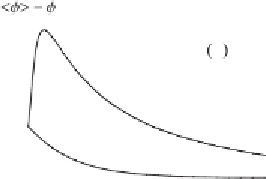Environmental Engineering Reference
In-Depth Information
p
φ
0
0.3
a
4
b
0.2
3
2
0.1
1
t
0.4
φ
1
5
10
0.1
0.2
0.3
φ
−
φ
0
obtained as an ensemble average of 10
6
real-
izations of model (
5.37
) with
a
Figure 5.18. (a) Behavior of
=−
1. The initial condition is
φ
=
0
.
1, and
s
gn
=
0
.
5
and
s
gn
=
5 for the lower and the upper curve, respectively. (b) Example of the
steady-state pdf of model (
5.38
)for
a
=−
1,
s
gn
=
5, and positive initial condition.
φ
=
In this case
f
eff
(
0
)
0 for any value of
s
gn
. The condition for marginal stability
is then
φ
0
=
d
f
eff
d
a
+
s
gn
=
0
,
(5.36)
φ
which provides the critical noise intensity
s
c
=−
a
. From condition (
B5.5-7
), it fol-
lows that
φ
0
is stable for
s
gn
<
−
a
and becomes unstable for
s
gn
>
−
a
. In the former
case, small disturbances around the steady state
φ
0
are dimmed whereas in the latter
they tend to grow exponentially for
t
0. However, this amplification is transient if
the spatial coupling is absent (see Fig.
5.17
): Fig.
5.18
(a) shows the temporal behav-
ior of the ensemble average of a number of numerically evaluated realizations of the
zero-dimensional stochastic model obtained when the spatial component is eliminated
from Eq. (
5.34
):
→
d
d
t
=
3
f
(
φ
)
+
g
(
φ
)
ξ
gn
(
t
)
=
a
φ
−
φ
+
φξ
gn
(
t
)
.
(5.37)
The results in Fig.
5.18
(a) show that the growth phase appears only when
s
gn
>
s
c
and
at the beginning of simulations (i.e., at short term), whereas the effect of the initial
perturbation disappears in the long term.
The steady-state pdf corresponding to model (
5.37
) can be found with the methods
described in Chapter 2:
2
2
s
gn
φ
a
s
gn
Ce
−
−
1
p
(
φ
)
=
φ
,
(5.38)
where
C
is a normalization constant and the domain of
p
(
φ
) is either the positive or
the negative semiaxis of
, depending on whether the initial condition is positive or
negative valued. In fact, the condition
g
(
φ
0 be a natural
boundary of the dynamics [an example of pdf is shown in Fig.
5.18
(b)]. Equation
(
5.38
) shows that the mode of the steady-state distribution is always at
φ
=
0)
=
0 entails that
φ
=
0forany
noise intensity. This confirms that in the long run perturbations of the deterministic
φ
=






















Search WWH ::

Custom Search